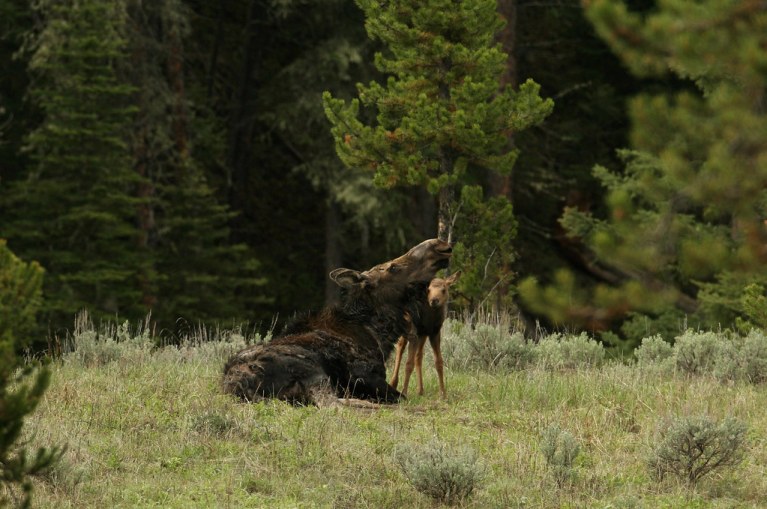The moose is the only species in the Alces genus. They are the heaviest and largest in the deer family. It is called an elk in Eurasia. An elk is considered a different species of deer in North America. The word moose was introduced into English in 1606 through the Algonquian language. It stems from the Narragansett word moos and mos from the Eastern Abenaki. All pseudonyms originated from the phrase moosu and Proto-Algonquian mo·swa.
An adult moose stands between four feet seven inches and seven feet from the ground to its shoulders. Bulls or males weigh up to fifteen hundred pounds. The ladies or cows weigh around four hundred fifty to one thousand ninety pounds. The tail is close to five inches and too short to ward off insects. The body and head measure eight to ten feet long. The largest subspecies is the Alaskan moose (A. a. gigas).
The feet consist of two smaller vestigial digits on the second and fifth toe. The third and fourth hooves are larger. The fourth is the broadest. The third is longer. The displacement is evolved for soft ground and increasing surface area to manage weight. The configuration aids in swimming. There are two layers of fur. A soft wool undercoat is covered by a top layer of guard hairs. The hairs are hollow and contain air for improved insulation and flotation in water. A fold of skin called a dewlap is found in both cows and bulls. There is no agreed purpose for its existence. Some suggest it assists in cooling. Others attest that it is a fitness signal used for mating or to show dominance.

Antlers
Females select partners based on the size of the bull’s antlers. Symmetry reflects good health. They are used to fight and flex. Most antlers are broad and flat and pointed along the exterior edge. Pattern variations occur across climates. Alaskan bull antlers have a spread greater than six and a half feet. It is maintained from five to twelve years or age. The size declines after their thirteenth year. The heaviest on record was seventy-nine pounds. The biggest spread was logged at six feet nine inches.
Moose are herbivores and love fruit. Adults need to eat twenty-three thousand kilocalories a day to maintain its mass. Up to seventy pounds of food is consumed every twenty-four hours. Forbs and willow or birch tree shoots fill a large component of their intake. Pondweed, lilies and other aquatic paints help satisfy sodium requirements. Road salt used to melt snow in the winter attracts the animal in droves. The quiet slap of a moose tongue reverberates throughout.
There are no upper front teeth. Eight razor sharp incisors line the lower jaw. A tough tongue and lips and gums help process woody vegetation. Six sets of large flat molars and six premolars masticate the meal. The upper lip is sensitive and can differentiate between fresh shoots and twigs. High branches are bent and stripped with immense dexterity. A moose can reach the tallest branches by standing on its hind legs. Fourteen feet is possible.

Predators
An adult moose has a few predators. Siberian tigers, the occasional brown bear and a pack of gray wolves are capable. Black bears and cougars stick to adolescents. Wolverines will dine on a moose as carrion. Wolves will stalk their prey for one to two miles. If a young moose is unobtainable, they will lure an adult into a shallow stream to decrease the target’s mobility. An adult will stand its ground. Defeat occurs after severe blood loss.
Moose are diurnal and active during the day. They are solitary creatures, but live near each other during the mating season. A calf and mother share a strong bond. Rutting is between September and October. Bulls fast two weeks before copulation. They are polygamous and share several mates. They attract their lovers through guttural calls that are returned by the ladies. Fighting is commonplace during selection.
Gestation last eight months. A single calf or twins are born in May or June. Twinning happens at a thirty to forty percent rate when nutrition is adequate. Newborns are born with red fur. Adults are brown. The calf will stay by its mother’s side for a year until it is replaced. The average life span is fifteen to twenty-five years. Populations are stable. Moose numbers are always expanding.

Scientific Classification
| Kingdom: | Animalia |
| Phylum: | Chordata |
| Class: | Mammalia |
| Order: | Artiodactyla |
| Family: | Cervidae |
| Subfamily: | Capreolinae |
| Tribe: | Alceini |
| Genus: | Alces |
| Species: | A. alces |
Moose Subspecies
| Subspecies | Name |
|---|---|
| A. a. gigas | Alaskan moose (Alaksa and Yukon) |
| A. a. buturlini | Chukotka elk (Siberia and Eurasia) |
| A. a. americana | Eastern moose (Canada and United States) |
| A. a. alces | European elk (Sweeden, Finland, Norway, Estonia, Latvia and Russia) |
| A. a. shirasi | Shiras’ moose or Yellowstone moose (United States) |
| A. a. cameloides | Ussuri elk (Russia) |
| A. a. andersoni | Western moose (Canada and United States) |
| A. a. pfizenmayeri | Yakutia elk (Mongolia, Siberia, Manchuria and Russia) |


What an informative article! New to your blog and looking forward to your articles. Love the vividness of the photos, makes me feel like I’m in the environment! From a brief review of your posts’ headings, I like what I see and look forward to perusing them. Thanks for sharing your knowledge! I would also like to read any feedback you have on my postings.
Thank you and anytime!